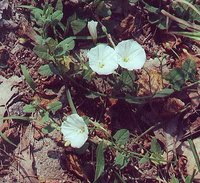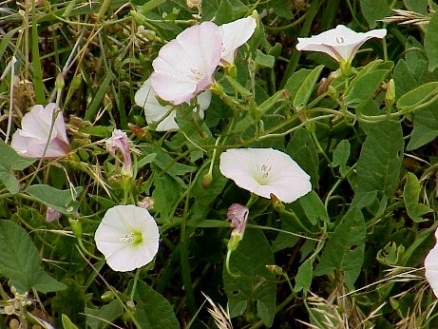Field Bindweed (Agricultural & Resource Economics)
Contents
Field Bindweed
Field Bindweed
Convolvulus arvensis L.
Common Names
Field bindweed, wild morning glory, European bindweed, creeping jenny, creeping Charlie, small flowered morning glory, perennial morning glory, field morning glory, devil's guts, orchard morning-glory, possession vine, corn bind.
Native Origin
Field bindweed is native to Europe, North Africa, and temperate Asia.
Description
 Field bindweed. Source: USFS.
Field bindweed. Source: USFS. Field bindweed is a perennial vine (0.4 – 2 inches in height) arising from deep, persistent, spreading roots. It has slender, trailing to somewhat twining, branched stems, 8 to 79 inches long, sometimes forming tangled mats. Simple leaves are variable, 0.4 to 4 inches long and 0.1 to 2.4 inches wide. Peduncles arise from leaf axils and bear 1 to 3 white or pink flowers from June to August. Fruits that appear June to September contain 1 to 4 dark brown or black sub ovate seeds. Taproots with a large numbers of annual lateral roots (2 to 10 feet long) develop throughout its length, and penetrate the soil in all directions. It spreads by rhizomes and seeds.
Habitat
It is found in a wide range of habitats: orchards, vineyards, roadsides, stream banks, lake shores, ditches and croplands. This species prefers strong sunlight and moderate-to-low moisture. It does not grow in wet soils.
Distribution
It is a serious weed problem throughout the continental United States
Ecological Impacts
Field bindweed intertwines and topples native species. It competes with other species for sunlight, moisture and nutrients. It poses threats to restoration efforts and riparian corridors by choking out grasses and forbs. It can decrease habitat biodiversity. It is one of the most serious weeds of agricultural fields in temperate regions of the world.
Toxicity
Mildly toxic to grazing animals
Control and Management
Field bindweed is difficult to eradicate because the seeds remain viable in soil for up to 20 years. One plant can produce up to 500 seeds. The deep, extensive root system stores carbohydrates and proteins and allows it to sprout repeatedly from fragments and rhizomes following removal of above-ground growth.
- Manual: Discing, tilling or hand pulling
- Chemical: Apply herbicide 2,4-D or glyphosate (Roundup); applications that trans-locate to roots, before seeds set
- Other approaches: Research suggests that shading will help control this species; mulching using paper, straw, wood chips, or black plastic can be effective in certain areas
Natural Enemies
Eight fungi and ten arthropods have been found on members of the genus Convolvulus.
References
- www.fs.fed.us/database/feis/plants/forb/conarv/all.html,
- Invasive Plants of Asia Origin Established in the US and their Natural Enemies p. 58-59
- WSSA-1,000 Weeds of North America: An Identification Guide
Editor's Note
Produced by the USDA Forest Service, Forest Health Staff, Newtown Square, PA. WOW 02-08-06
Invasive Plants website: http://www.na.fs.fed.us/fhp/invasive_plants
Field Bindweed Convolvulus arvensis L.
